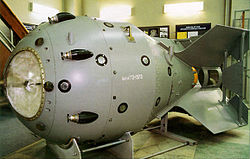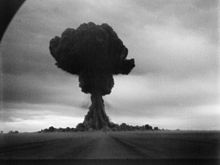- RDS-1
-
Coordinates: 50°26′15″N 77°48′51″E / 50.4375°N 77.81417°E
RDS-1
The first Soviet atomic bomb, "RDS-1", was an implosion type like the U.S. "Fat Man" bomb, even in appearance; the front "eyes" are radar fuzes.Type Nuclear weapon Place of origin Soviet Union Specifications Blast yield 22 kt (92 TJ) The RDS-1 (Russian: РДС-1), also known as First Lightning (Первая молния, Pervaya molniya), was the Soviet Union's first nuclear weapon test. In the west, it was code-named Joe-1, in reference to Joseph Stalin. It was test-exploded on 29 August 1949, at Semipalatinsk, Kazakh SSR, after a top-secret R&D project.[1] The weapon was designed at the Kurchatov Institute—at the time officially known as "Laboratory № 2," but designated as the "office" or "base" in internal documents—starting in April 1946. A uranium-235 plant was built near Chelyabinsk in 1948.[1]
The RDS-1 explosion yielded 22 kilotons of TNT, similar to the American Gadget and Fat Man bombs. At Lavrenty Beria's insistence, the RDS-1 bomb was designed after the Fat Man bomb dropped on Nagasaki, Japan. Like Fat Man, it was an implosion type weapon with a solid plutonium core. The bomb designers had developed a more sophisticated design (tested later as RDS-2), but the "Fat Man" bomb was used for its known reliability. The USSR had received extensive espionage on the design of the "Fat Man" bomb during World War II (see atomic spies).
In order to test the effects of the new weapon, workers constructed houses made of wood and bricks, along with a bridge, and a simulated metro in the vicinity of the test site. Armor hardware and approximately 50 aircraft were also brought to the testing grounds, as well as over 1,500 animals to test the bomb's effects on life.[1] The resulting data showed the RDS explosion to be 50% more destructive than originally estimated by its engineers.[1]
There are several explanations for the USSR code-name of RDS-1, usually an arbitrary designation: a backronym "Special Jet Engine" (Реактивный двигатель специальный, Reaktivnyi Dvigatel Specialnyi), or "Stalin's Jet Engine" (Реактивный двигатель Сталина, Reaktivnyi Dvigatel Stalina), or "Russia does it herself" (Россия делает сама, Rossiya Delayet Sama).[1] Later weapons were also designated RDS, but with different model numbers.
Mikhail Pervukhin served as the chairman of the commission in charge of the RDS-1 testing.
Contents
Response in the West
When the radioactive fission products from the test were detected by the US Air Force, the US began to follow the trail of the nuclear fallout debris.[2] President Truman notified the world of the situation on September 23, 1949: "We have evidence that within recent weeks an atomic explosion occurred in the U.S.S.R."[3] This statement was a turning point in the Cold War that had just begun. The Green Run was a secret test carried out to help the US Air Force's reconnaissance for future detections of Soviet atomic tests.[4]
Once the Soviet Union was confirmed to be in possession of the atomic bomb, pressure mounted to develop the first hydrogen bomb.[3]
See also
- Soviet atomic bomb project
- RDS-37
- RDS-220
References
- ^ a b c d e Peslyak, Alexander (August 31, 2009). "Russia: building a nuclear deterrent for the sake of peace (60th anniversary of the first Soviet atomic test)". RIA Novosti. http://en.rian.ru/analysis/20090831/155977682.html. Retrieved 2010-04-05.
- ^ U.S. Intelligence and the Detection of the First Soviet Nuclear Test, September 1949, William Burr, Washington, DC, September 22, 2009
- ^ a b [1]
- ^ Miller, Richard L (1991). Under the Cloud: The Decades of Nuclear Testing. The Woodlands, Texas: Two Sixty Press. pp. 71. ISBN 0029216206. (See Google Books)
External links
- Information about Joe 1 from Carey Sublette's NuclearWeaponArchive.org
- http://www.atomicmuseum.com/tour/coldwar.cfm
- http://www.kazakhembus.com/Nuc_gp.html
- Video of the Joe-1 Nuclear Test
Categories:- Cold War
- Soviet nuclear explosive tests
- Nuclear bombs of the Soviet Union
- 1949 in the Soviet Union
- Nuclear weapons policy
- Nuclear proliferation
- 1949 in international relations
Wikimedia Foundation. 2010.


